#inter-community hostility
Explore tagged Tumblr posts
Text
I think it’s also important to accept that sometimes people will be wrong about their own identity. I mean, sometimes the leading experts in a field are still figuring things out or working without all the information, you know? It’s part of the process.
Sometimes people will be wrong about their identities, and that’s okay. They’re on a journey and this is a step in that journey. It is not your job to fix or correct someone. You should NOT try. You can never know for sure who still has some serious learning ahead of them about themselves. It’s is NOT in any way morally wrong to still be in the process of learning about your identity or even be mistaken about your own identity. It’s part of the journey to learn about yourself.
If someone’s a close friend you can serve as a sounding board and maybe gently tell them the impression they give you if they’re open to it, but that’s it. It doesn’t matter if you’ve been right about people in the past or not. Do not try to “fix” anyone’s identity. It literally does not matter if you’re ultimately right about where they end up in terms of labels, that is their journey and you don’t truly know it.
I gotta say, so much queer intra-community horseshit dropped off my shoulders when I decided to adopt a firm policy that everyone is the expert in their own identity, the single most knowledgeable person about what it's like to live life in their own skin, and that if someone describes their experience in ways I find contradictory or paradoxical I should do them the courtesy of presuming that they are striving to express something very specific and nuanced, rather than leaping to the conclusion that they're just dumb and using words wrong.
Sure, there are some combinations of identity terms that I look at and go "hmm, I don't get how that works." I'm still a human being. But there's a big difference between not getting how something works versus insisting that it doesn't.
#adding this on because people can be questioning and/or mistaken#and those people still deserve autonomy#and you will never help them by insisting that you know themselves better than they do#they need to take their own journey and you can never do that for them and you will more than likely hurt them if you try#ask to tag#inter-community hostility#loving queue#maybe that asexual will turn out to be gay maybe that bi lesbian will turn out to be very bi and if that is so it's their personal journey#that you get none nada zip zero say in#i just think in our rhetoric about respecting people's identity we should acknowledge that people do sometimes get it wrong and that's okay#they still deserve respect 100%#i've gotten it wrong#being pressured never would help me ever
61K notes
·
View notes
Text
Have you ever considered how your relationship with a monster could be judged by your community?
TW: racism
You’d think that a world where humans and monsters freely mix would make it easy to pursue inter-monster relations, but the truth is that old barriers die hard.
From the moment you got with your Monster BF, you’ve attracted an array of criticism. Guys that complain about you ��stepping out’ instead of getting with someone of your own species. People and monsters who couldn’t accept that you could be with someone significantly bigger and stronger than you without it being ‘icky’. People who try to ‘psychoanalyze’ you, calling you all sorts of insults thinly veiled as medical and political jargon.
And your Loving BF had to endure such insults from the monster community, as well. Continually mocked for being so ‘weak’ He could only handle the frailest of races, not being monster enough to handle one of His own kind. Hurled accusations of exploiting a weak human, that He relished in such an exploitative power imbalance. Insinuations of fetishizing a creature He could easily control.
They couldn’t be farther from the truth. Granted, He is more than plenty for you, which you absolutely adored, and He loved overpowering you with His mind-blowing lovemaking. But that was only part of the equation. They didn’t see how your personalities meshed together as a unit. They didn’t see his beautiful little quirks, and how cutely He responded to your own. They couldn’t see how He just… gets you. Like a piece that just fell in perfectly completing you. You loved Him for who he was, and He loved you for who you are, and that chemistry was what made everything special. Including the bedroom.
But lately, its like no matter where you go, you cant escape the judgements and microaggressions. The two of you could go out to a restaurant together and you would feel all the waiters do a double take. Maybe your tea glass stays empty most of the time as they prefer to avoid the awkwardness of addressing a human and monster together. Maybe their attitude is a little off, as their reactions to this ‘uncanny’ relationship range from apprehensive curiosity to downright hostile.
You’d be hyper-aware of your bruising when your Monster S/O rails you a little too hard. You’d happily claim them as badges of honor, but you’ve been cornered by one too many humans ‘concerned’ that Your Monster may be taking advantage of you. And despite your refutations and continued defense of Your Lovely BF, its starting to get to your head.
You can feel the eyes everywhere, the silent judgement from both humans and monsters. When you showed up to his workplace to surprise him, you got ignored by the monsters, assuming you were some thirsty bitch hoping to harass one of their workers. When He showed up to yours, your coworkers refused, without even consulting you, assuming someone like you would -never- allow yourself in the clutches of a monster like Him. When you bitched them out for that, they doubled down, even though they’ve let other S/O’s visit.
You love your Monster Boyfriend to death, and you know that part of being in a relationship is to deal with all the hardships together and be stronger from it. But it’s like an eternal pressure building against you: never letting up, never letting go, and it feels like someday it's going to topple over and bury you. You wish you never had to deal with this at all.
And from how crushed He's been looking lately as well, it’s been getting to Him, too.
115 notes
·
View notes
Text
Minotaurs
Masterlist and taglist below the cut.


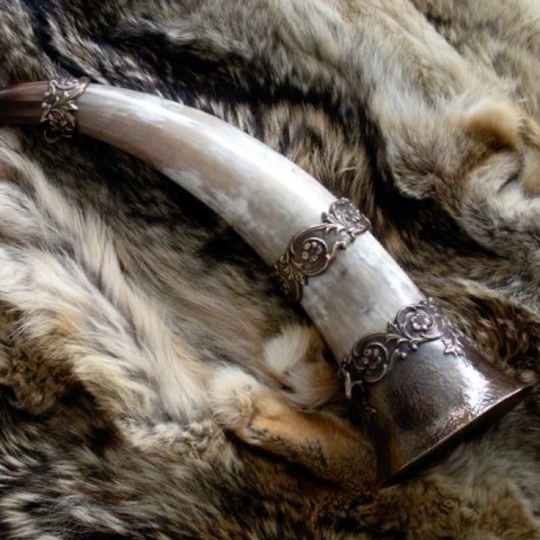


Physical description
Minotaurs are large, bipedal creatures with bovine features. They are covered completely in fur, which comes in a variety of textures, lengths, and colors. Depending on the genetics of the herd, which tend to be homogenous, minotaurs can grow anywhere between 7 and 10 feet tall. The fur helps them withstand the elements but some herds wear decoration. Flowers and brightly colored feathers are popular choices.
Social
Minotaurs live in communities of up to fifty called herds. These herds usually follow linear hierarchies with an elder matriarch and the largest bull at the top. Most herds are predominately female, as young bulls in a single generation often choose to live nomadically before settling with herds of their own though this has changed with the fertility crisis.
Minotaur herds are self-sufficient and don't see much benefit to engaging with other species. In fact, their most notable inter-species relationships are hostile. They compete with centaurs for many resources and predatory creatures like werewolves, gnolls, and even orcs can prove threats.
Minotaur herds usually take good care of their humans, particularly those who give birth. This is because minotaurs naturally respect mothers and the matriarch will often take special care of the humans in the herd, determining their matches. The bull of the herd will often claim a human's first calf but will concede the need to diversify a gene pool. Humans who can impregnate are still treated well though, even if they might illicit jealousy from the bull of the herd. Minotaurs prefer to hoard their humans.
Environment
Minotaurs settle in temperate climates in clearings near woods. Oftentimes, they will cut down a large section of forest to create a clearing where they will use the lumber to build a barn-like lodge. These lodges have individual "stalls" for couples, parents and children, siblings, and individuals. The lodge opens on both long ends and the center walkway is wide enough to accommodate a communal table for dinners which can be put up during the day for space to work.
Procreation
Minotaurs reproduce sexually by inserting a penis into a vagina to deliver genetic material. Minotaur babies need roughly nine months of gestation in a womb, sometimes more. They are typically over 15 lbs when born and need milk for the first few months.

Masterlist
Husk x Reader (Minotaur bull x gender neutral afab!reader)

Taglist: @leitor-sonolento, @kittycatkandies , @ren-lives-here , @tiredsleepyhead
Part of the Monster Ark verse.
Relied on this document for some lore-building.
#monster lover#monster fucker#monsterfucker#monster fudger#monster kink#terato#monster fluff#minotaur#monster ark
39 notes
·
View notes
Text
i think we gotta be more careful about falling into the trap of placing heaps of blame on the most vulnerable groups around us because it’s easier, emotionally or otherwise, than going after those in power. like i mostly talk about transandrophobia right now and how transmascs get so much shit thrown at us because were easier to attack than cis people, and i’ve seen people do the same thing to transfems and NBs too. to me it’s extra disappointing when it’s someone who is vocally supportive of transmascs doing it (like generalizing all transfems as being hostile to transmascs/being transandrophobic). it’s of course important to talk about inter community issues and point out harmful behaviors and ideologies when we see them, and talk about how someone’s life experience might lead them to be that way, but singling out one type of trans person as The Culprit is not helpful and just feels like it further drives a wedge into our community. we may be able to perpetuate aspects of the transphobic systems cis people put in place, but none of us are responsible for them and we don’t benefit from them, past surface level “acceptance” from people who’d be more comfortable if one type of trans person or all of us didn’t exist at all
#it honestly is really hard to call out harmful behaviors a trans person might exhibit because transphobia is so rampant rn#on one side you’ve got people who will demonize a trans person for existing and on the other there’s people who refuse to believe-#-trans people can do any wrong#i think the former is Much worse but they’re both still bad#it kinda makes sense that ppl resort to black n white thinking cause it feels like there’s no middle ground#but like. it doesn’t have to be that way. we can defend ourselves while acknowledging our ability to do wrong#we’re human not perfect machines and i think being able to make and learn from mistakes without being completely socially ostracized#should be a part of trans liberation#transandrophobia#transmisogyny#transphobia#oh also i’m trying to think more carefully about saying ‘x kind of trans person experiences y’#or ‘trans people ESPECIALLY x kind of trans people experience y’#because i’ve noticed people will assume things that happen to transfems never hppen to transmascs#and i don’t want to perpetuate that kind of thinking regardless of what trans group i’m talking about#tbh i think there’s VERY FEW circumstances where you can confidently say a certain kind of person never experiences something
33 notes
·
View notes
Text
CARBON LORE: Society and Diggers
Carbon society is distinguished by the large number of islands on which they reside. As a result, a variety of cultures emerge, with the ruins of the previous society serving as a foundation for further development. The majority of these cultures differ from one another, but they all share a common concept: community. Most islands have tight-knit communities that frequently assist one another in difficult situations. They rely on others' assistance to ensure the process and, potentially, a more relaxed attitude. Because of cultural differences between the islands, there is no unified government, and the primary goal of these civilizations is to foster inter-island relations. This has resulted in a one-of-a-kind era of peace within carbon societies, akin to their halcyon days, but there are still problems that must be addressed.
Carbons use a mix of basic and ancient technology. Most of their civilization employs these ancient technologies. It also means that their power sources cannot be replicated easily, as they are not capable of creating a power source. Instead, they must locate and uncover its primary power source. Refractors are mostly found in ruins scattered throughout the planet. This type of responsibility is assigned to the Digouter, which translates as "digger."
Diggers include explorers, treasure hunters, and others. Their primary duty is to search the ancient ruins of Terra for valuable relics, technology, and refractors. They are responsible for ensuring that their civilization has enough power and resources, so they rely on their own efforts. Unfortunately, being a digger is not as easy as it appears, as there are more risks and dangers. The terra's ruins can be dangerous for a variety of reasons, including traps, hostile reaver bots, and the possibility of trickster spirits (Cyber Elves) leading diggers to their demise. As a result, many diggers require training to prepare them to deal with the dangers of the ruins. Most diggers begin their training at the age of ten, but due to their durability, they can withstand it. Diggers typically work in groups of two or more to ensure the success and survival of an expedition; those who go out alone are considered suicidal. Whoever survives as a lone digger with resources in tow is considered exceptionally skilled. Unfortunately, they are diggers who are motivated by greed and fortune and do not respect the law. They are commonly known as "air pirates."
Despite the many dangers of the job itself, many diggers choose either a sense of responsibility, adventure, or something more. In order to support diggers, an organization was formed to not only support them but also their civilization, called “The Digger’s Guild”. An interconnected organization whose main responsibility is to help islands and diggers alike. The guild is where Diggers can find different jobs to help people or support them. This leads to a unique distinction between Guild Diggers and Independent Diggers. While guild diggers are the ones that mostly stay on their main island to help the people there, dealing with difficulties, etc. The majority of the refractors they give to the guild are distributed among other diggers and islands. Meanwhile, an independent digger works alone or with their loved ones, typically traveling across Terra by airship, collecting relics and refractors to keep or trade to a nearby settlement. They frequently sign contracts to get jobs or, on occasion, accept a job from the guild to assist in a large expedition or something else.
#megaman x#megaman legends#legends reborn#headcanon#lore#yes I posted these at the same time qwefkjhweqckjhecqwhkj#But yeah the concept of digger’s guild is based on Pokémon guilds#these lore tags are meant to help folks understand my interpretation of megaman legends bjasddjbsakds#ygkhkiououihmg
46 notes
·
View notes
Note
Akari and Ingo, what do you know about a Susie Que?
Depot Agents, if everything goes well, there may be a feral teenager running around Gear Station with multiple legendaries. She will bite. Are you afraid?
Emmet did you know that identical twins are not 100% matching in DNA? That may be the reason why you can only grow a mustache.
And please, when Ingo returns from Hisui, teach him to be a civilized human being. He's been a wild mountain man for too long.
And Lady Sneasler, have you tried dying Melli's hair yet?
Your ask has been distributed to all relevant parties!
stuck-in-the-past: i dont recognize the name and ingo just shrugged :/ stuck-in-the-past: should i know that person XD
concerned-and-confused: if everything goes WELL???? lostinthesinistea: Depends. Is this teenager venomous and/or actively hostile? Do repels work against her? How many legendaries does she have and are they well trained?
joltikmas: shafted by god yet again joltikmas: first it took my brother and now its taken my facial hair joltikmas: being a wild mtn man sounds like fun tho joltikmas: we can both be feral together (ノ◕ヮ◕)ノ*:・゚✧
stuck-in-the-past: i showed her how adaman got his hair to be blue and i swear i could see the gears turning in her head stuck-in-the-past: will keep u updated on the state of melli's hair
Thank you for using Arceus Inter-Dimensional Communication!
#zef askbox#pokemon#pokemon legends arceus#pokemon black and white#pokemon akari#pokemon ingo#submas#subway boss ingo#warden ingo#pokemon emmet#subway boss emmet#lady sneasler#pokemon depot agents#pla social media au
14 notes
·
View notes
Text



The Consequences of Motorisation
In the past, cities and towns were built to the scale of the walking person, and pedestrians, vehicle users, horse, cart, carriage, cycle, bus, car, lorry all had the same physical access to buildings. This equality has disappeared with the increasing speed (and volume) of motor traffic. Along main arterial roads barriers are put up to speed traffic flow; they also prevent pedestrians from crossing and motorists from parking so car users and bus passengers can no longer use local shops. The next stage is that a hypermarket opens elsewhere killing off small shops and forcing pedestrians and bus users to shop there or go to the more expensive shop on their estate (with its monopoly of local trade). Cities become compartmentalised, area by area. At the core is a hostile city centre defended by an urban motorway, its inhabitants gone. It is surrounded by a series of neighbourhoods hemmed in by fast-moving traffic on long arterial roads carrying commuters and freight back and forth. People can only enter or leave the city at controlled points. The city is fragmented, with no inter-connectivity between communities or people. Further out a series of scattered encampments – the outer suburbs — cluster the ring road. Cities devoid of life, with traffic endlessly circulating around ring roads. The poor from different areas never meet, leading totally separate existences. Thousands of people live in their own niche within neighbourhoods, isolated and atomised in their own homes.
#anarcho-communism#anarcho-primitivism#anti-capitalism#capitalism#class#class struggle#climate crisis#colonialism#deep ecology#ecology#global warming#green#Green anarchism#imperialism#industrialization#industrial revolution#industrial society#industry#mutual aid#overpopulation#poverty#social ecology#anarchism#anarchy#anarchist society#practical anarchy#practical anarchism#resistance#autonomy#revolution
10 notes
·
View notes
Text
Fuck it, I created a new Mortal Kombat race for an OC.
Race: Strakteran
History: The Strakteran were once one and the same with the Kytinn, a race of insectoid hive-mind creatures that hail from the island of Arnyek. At some point in their timeline, after the introduction of outside life forms, the species began to branch and evolve. While Kytinn are winged and form from larvae implanted into hosts, Strakteran take their characteristics from arachnids. It is theorized that many other insectoid races branched off as well, adapting to survive in various climates and against various threats.
Distribution: The Strakteran are a matriarchal society that hails from Ondarak, a rocky and rather inhospitable world comprised of deep cave systems and short daylight hours.
Etymology: Strakteran can have various levels of resemblance to their arachnid counterparts, with some sporting eight eyes, while others have six or four. Occasionally, a Strakteran will be born with only two, but they typically dwell closer to the surface in more well-lit areas or have had inter-breeding with binocular races. Most, if not all, have eight appendages, with four dedicated to movement and four that function as arms.
Strakteran possess mouths equipped with mandibles and venomous fangs; the level of toxicity in their venom is dependent on their subspecies.
Strakteran use many different methods of hunting, much like their arachnid counterparts. Most weave webs, while some prefer to chase prey, and still others use traps.
Strakteran are oviparous, reproducing by laying eggs in large clutches. The highly competitive pursuit of prey and territory often results in eggs being the target of rival clans.
Society: Unlike Kytinn, Strakteran do not have a hive mind, allowing each to act independently, though the matriarchal nature of their society does mean that females hold a higher rank.
Strakteran form "clans", small to midsize pods that center around the most mature female.
Envoys from various realms have attempted to make contact with the Strakteran, but are almost always met with violence. After Shao Kahn's annexation of Arnyek, they became wary of and hostile toward outsiders.
Culture: Though at first glance they may seem barbaric, Strakteran do have some semblance of culture; researchers have observed them vocalizing in what resembles song and have also recorded art on cave walls.
Strakteran young are cared for by the females of the clan in a communal setting, and orphans from other clans have been observed being accepted by former rivals.
#strakteran#mortal kombat races#mk ocs#i wrote this like a wiki page whatever#long post#will edit and hone later
35 notes
·
View notes
Text
today is the 17th of may aka IDAHOBITA* (international day against homo- bi- inter- trans- aspec-hostility). officially it's "phobia" but I've chosen to adapt the practice of (german) queer activists to speak of queer-hostility. while you may argue it's based in a fear of the unknown, the related actions be it individual or systematic are not. they're hostile and threatening to queer lives.
today I'm thinking of those who have experienced (and continue to experience) queer hostility. those who experience it as violence. those who experience it as a legal system. those who experience it from the people meant to support and protect them. those who experience it from strangers. those who experience it and can't talk about it. thise who experience it and are vocal about the injustice. I'm thinking of you and I'm sending you a hug, a shoulder squeeze, a handshake, an affirmative nod. the suffering will end, the hostility will end, we deserve to live peaceful and joyful lives
today I'm asking cis, hetero, allo & endo people to become our allies, to seek out information how to support the queer community better. how to take allyship further than "yeah I'm chill with that". I'm asking you to speak up, to get loud, to get active. I'm asking people who aren't genderqueer and/or trans to become allies to trans and genderqueer people. I'm asking endo people to become allies to intersex people. to make space for conversations about gender, not only about breaking binary stereotypes but about allowing a multitude of complex relations to the idea of gender (including the rejection of it! not everyone has a gender, agender ppl exist!). I'm asking allo people (queer or not) to become allies for the aromantic and asexual community. love is love is a beautiful slogan, but love is not all there is and tbe split attraction model is a thing. amatonormativity is real, different forms of complex relationships are real and conversations about these and the experiences of aromantic and asexual people deserve space and attention.
today is a great day to learn about the hostility queer people experience, to show solidarity, to celebrate our wins and fight for more
#trying to put into words how I feel on days like today isn't easy so this is an attempt#bente rambles#idahobit#idahobita#as per usual idk what to tag this as#queer studyblr#queer uniblr#knife gang#mine
16 notes
·
View notes
Text
G Witch Onscreen Text: Episode 4
This is part FIVE in an ongoing series where i transcribe and discuss the text on monitors and screens in G Witch ! Because I just LOVE words ! We are on episode 4, "Unseen Trap"
<< Click here to go back to Episode 3!

(You reading this post rn) Join me....Under....The Cut....


This seems like a good a time as any to mention that in the Shukufuku opening, Suletta and Miorine are calling each other on the phone.
This gives us a good look at how the current Holder has a Golden Asticassia emblem on their notebook compared to the standard dark blue (compare Suletta's phone to Miorine's) and looking at Miorine's phone shows us that the Holder's first name is rendered in gold as well.

The interface of the online meeting program Vim is using to talk to his investors. We see this same program without changes used 21 years ago in the prologue. It seems that even in the future we never escape the twisted machinations of Zoom meetings....truly this too, is hell.


TEXT: (Left Image, Top Left) THREAT DETECTION EXERCISE EXERCISE PLAN: SEARCH SUPPORT IN MINE AREA
(Right Image, AREA MAP) SIMULATED MINE NO DETECTION MINE DETECTION MODE
The interface of the Threat Detection Exercise as well as the area map, used by the Spotter in the exercise.

TEXT: (Top Left) WEAPONS EXCHANGE AND UPGRADE CONTROL CONNECTIVITY TEST DEMI TRAINER MSJ-121 (Center) WEAPONS EXCHANGE MODE LINK CONNECTION: 72% CONNECTIVITY TEST
This is the screen seen by the Mechanic in the exercise, when the Demi Trainer swaps out its hand for the test gun to use in the second half of the exercise

TEXT: (Top Left) PASSIVE RADAR: UNAVAILABLE ACTIVE RADAR: UNAVAILABLE INTEGRATED COMMUNICATION SYSTEM: AVAILABLE
(Center) EXERCISE MODE EMISSION CONTROL SYSTEM
The screen inside the Demi Trainer, showing the mode its set to. A neat detail is that, in the top left, we can see that the passive and active radars are unavailable, which makes sense as that's the point of the exercise.
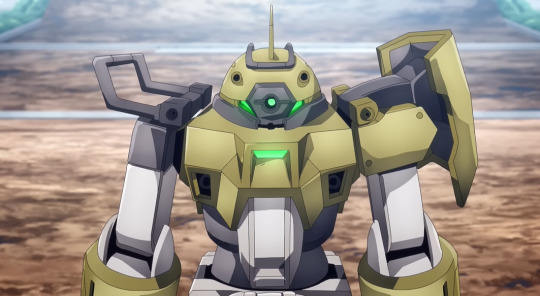
Not text, but did you notice that Chuchu is allowed to use her own custom Demi Trainer in the exercise? That's neat !
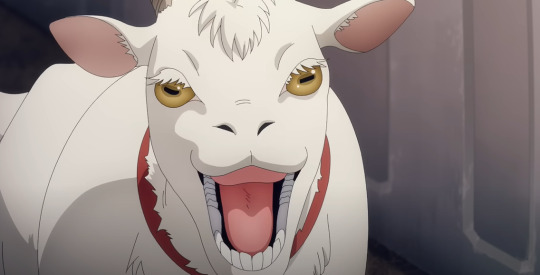
TEXT: Goat Noise
Analysis: This is a goat, I think
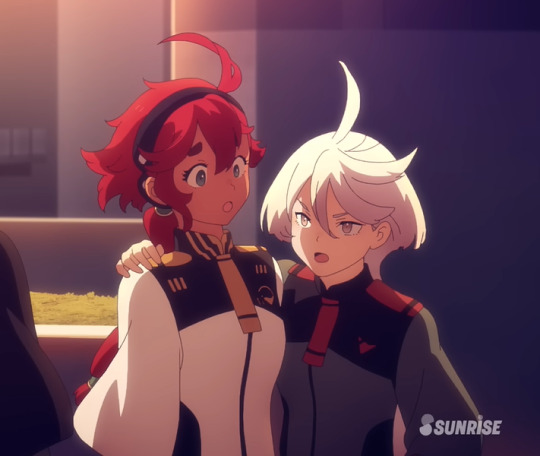
TEXT: GAY PEOPLE
Analysis: hehehe....eehehehehuhuhuuu....teehee! Teeheheeeehheee...uwaaaaa..!


TEXT: (Top Image, From top to bottom) THREAT DETECTION EXERCISE EXERCISE PLAN
PARTICIPANT TEAMS: Student teams made up of Pilots, Mechanics, and Spotters [data analyst]
EXERCISE ELEMENTS: DETECTION: Investigate MS threat using simulated mines. SNIPING: Respond to MS threat by shooting targets.
TEAM OBJECTIVES: Harmonize MS threat response capabilities with task requirements Enhance cooperation between Pilot, Mechanic, and Spotter with a strengthened inter-team approach. Continue to assess cross-functional MS threat response in hostile environments, operating under new concepts.
EXERCISE ELEMENTS FOR STUDENTS:
Pilot: Manual operation via direct visual recognition. Traverse mine area. Exchange weapons. Target sniping in shooting area.
Mechanic: Preliminary Maintenance. Support weapon exchange. Mid exercise repairs and adjustments.
Spotter: Search support in mine area. Search support in shooting area.
For details, please see >>HERE
EXERCISE SUPERVISION MS Threat Response Center
EXERCISE PLANNING TEAM MS Threat Response Center : 4th planning team
(Bottom Image) Reading Completed. You will receive a confirmation message once you have read this EXERCISE PLAN.
So, there's a lot here...lot of words. But there are 2 main takeaways I think, one more important than the other.
The first is that if you look under the Mechanic's responsibilities, you can actually see that "Preliminary Maintenance" is one of their duties, so while the teacher for the exercise was definitely being harsh when he wouldn't let Miorine suspend the exam to clean the spray off their Demi Trainer, he wasn't lying when he said that it WAS a part of the assignment.
The second is that this is a BIG manual, and Miorine somehow had it completely memorized (and able to put it into practice) by only reading through it one time. This is meant to demonstrate that she's very smart, obviously, but I think it's also implying that she has a photographic memory. (Which is how she had the entire genome sequence of her mother's tomatoes just at the tip of her fingers)

TEXT: (NOTE: For the sake of legibility, Suletta's correct answers will have an OK, and her incorrect answers will have an X) (Top to bottom) PILOTING DEPARTMENT ID No: LP041 NAME: SULETTA MERCURY
TEST: MOBILE HEAVY MACHINERY ENGINEERING PRINCIPLES ANSWER THE QUESTIONS BELOW >> 50 MIN.
QUESTION: 1. WHAT ARE THE FIRST FOUR STEPS IN THE MOBILE SUIT AND MOBILE CRAFT DESIGN PROCESS?
OK: PLAN. TEST. EVALUATE. IMPROVE.
2. WHICH OF THE FOLLOWING WOULD NOT BE A CONSIDERATION IN MS DESIGN?
X: LEGAL RESTRICTIONS FOR CIVILIAN MOBILE CRAFT.
3. WHAT IS THE DIFFERENCE BETWEEN MS AND MC?
X: MS ARE MORE DIFFICULT TO OPERATE.
4. WHAT ARE THE BENEFITS OF PERMET-LINKED MS AND MC?
OK: SIMPLIFIED CONTROL MANAGEMENT. IMPROVED USABILITY.
5. WHO CREATES THE PROCESSES TO MASS PRODUCE NEW MS AND MC FOR CONSUMERS
X: FACTORY PERSONEL .
6. WHY IS IT IMPORTANT TO WORK TO A DETAILED SPECIFICATION WHEN ASSEMBLING MS FOR USE?
X: FOR WORK SAFETY.
Number 7 can't be made out. It has the word "LINK" in it though.
So, as we can see here, Suletta is not doing very well in her class. Out of the 6 questions we can see, she only got 2 right. You can't really blame her too much though, she's never been to a school before...
I think my favorite of her incorrect answers is Number 5. You can just see her reading that question, tapping her tablet pen on her lip before going, Oh! The people in the factories make the mobile suits, it has to be them!
Do your best Suletta...!
(The Asticassia emblem is also golden on her tests too. They REALLY will not let you forget that ur holding.)

TEXT: (From left to right) JUSTICE AND PEACE FOR EARTHIANS WE ARE SUFFERING! EARTHIAN RIGHTS WORK OR RESIST! DOWN WITH SPACIAN OPPRESSION SPACIAN CAPITALISM KILLS!

TEXT: BREAKING NEWS: DEMONSTRATORS TURN VIOLENT INSIDE EARTH FACILITY! EARTHIAN EXTREMISM RISING
If you aren't paying attention to the news report, the utter dissonance of the actual incident we just saw of Mobile Suits and gas canisters big enough to leave dents in the street being used against unarmed civilians running for their lives being reported on as the demonstrators themselves being violent extremists could be lost on you.

The actual words the news anchor uses here, "Business administrative laws" being enforced on "an illegal occupation" also serves to remove agency from spacian corporations and push blame onto the earthians. (You can also see this in the prologue)
It's like Martin says, the major media companies (like INN) rely on Spacian Capital, and their reporting on these topics will always be inherently biased towards the people keeping their lights on.
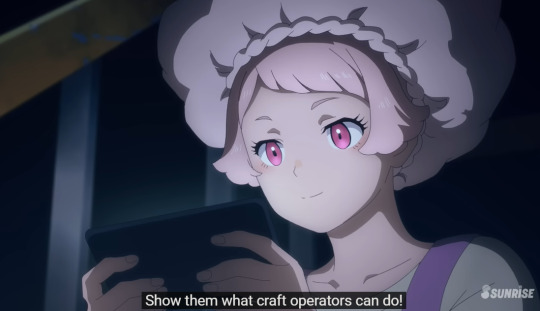
Not text, but Chuchu's family at home seem to primarily be mobile craft operators. (This is probably why in the epilogue, she appears to be working AS a mobile craft operator with Rouji)

Not much here, but I figure it important to mention that in the bottom left, you can see that the Demi Trainer ALSO has a Cockpit Voice Recorder. I had assumed it was strange for Aerial to have one, but perhaps it's standard for all MS units?
Regardless, I wouldn't put it past Prospera to use such a thing for her own ambition...
And that's all four episode 4 !! Not as much text this time, but there was still a lot to talk about!
And of course, as thanks for once again reaching the end, I have a gift for you...come closer....
...
.....
...
...


ONE THOUSAND KILLING BLOWS TECHNIQUE 👊👊👊👊👊👊👊👊👊👊👊👊👊👊👊👊👊👊👊👊👊👊👊👊👊👊👊👊👊👊👊👊👊
DIE ONE MILLION DEATHS
If you aren't dead, click here to go to Episode 5! >>
If you aren't dead but hate chronological order, click here to go to the Masterpost!
47 notes
·
View notes
Note
(not the original "maga communism" anon)
tbh i'm not so sure the kke's analysis is not homophobic (or transphobic), i read their statement on same-sex marriage and it rubbed me the wrong way. i don't think it was an issue of translation
https : // inter . kke . gr /en/articles/The-position-of-the-KKE-on-civil-marriage-of-same-sex-couples-and-its-impact-on-childrens-rights-00001/
what do you think of the text?
I hadn't read this text, like I said my opinion was informed on conversations with two KKE militants. The text flip-flops between what I'd consider a principled (albeit rushed in the context of their material situation, marriage abolition is not a realistic position to take at this time) rejection of marriage and the state involvement in it, along with a good point that just legislating marriage won't solve the oppression queer people suffer, and between backwards ideas of parenting and gender. I do think they do genuinely not oppose homosexuality in itself, like they say, they express that they don't think two men or two women can adequately raise a child because of "motherhood and fatherhood".
In the original post you're replying to I did say that "I am not saying that the KKE is free from reactionary tendencies and that it's a paragon of absolute social progress, but just like it isn't that, it is also not comparable with crypto-fascists or glorified socdems playing into transphobic or racist tendencies." and that, in the context of communist parties in the past "Just like we can understand that an individual communist today may be insufficiently educated and express reactionary views and hurt people because of this, I think the analogy can be made that these past communist people and parties hadn't yet been sufficiently educated by practice and theoretical discussions. We can't ignore the harm that they did, but we can recognize that it was in no way necessary, and that it was counterproductive, so we can acknowledge those mistakes, carefully separate those elements from the rest of their achievements, and learn about them.". And I still think these two statements hold true.
The KKE is a historical communist party, one that did not follow eurocommunism. While I'm not intimately familiar with the makeup of their Central Committee, it does seem that their 100 year trajectory along with the resistance against reformism has made their leadership entrenched in excessively orthodox anti-western positions, and they do identify the connection between pro-NATO elements in the Greek parliament with advancing queer rights: "It is important to note that government officials, in order to promote the bill, resort to crude anti-Sovietism and anti-communism, linking its promotion to the further integration of our country into the "camp" of Euro-Atlanticism".
The KKE is still an extremely positive force for Greek workers, their capacity for organization is unparalleled anywhere else in Europe, and I'm certain that, if the sufficient opportunity presented itself, they would be able to overthrow the Greek government. And like I said in the other post, we can acknowledge that, as harmful and backwards as their stated positions are, we can't wholly reject their project because of it, and we can probably expect these positions to change as leadership is renewed. I believe this because one of these militants I talked to is trans, and they (using a gender neutral pronoun to protect their identity as much as possible) do not feel unsafe within the KKE.
TL,DR: Yeah, some positions in that text really suck and are homophobic, transphobic, and generally backwards. But the context of the development of the party and my communication with a couple of militants leads me to believe it is not hostile within their ranks, and that they will improve on this sooner rather than later.
8 notes
·
View notes
Text
Old Gay VS New Gay discourse is so interesting to me as a “new gay” (milennial) growing up around “old gays” (boomers)
Old gays refuse to adapt to new nuanced gender and sexuality labels, feeling they’re superfluous and not “real issues.” New gays refuse to understand the point of view of a community not that long ago that was ravaged by AIDS and was (and is) straight-up illegal in public to be in most parts of the world
It’s a microcosm of the boomer/milennial dichotomy and imo shouldn’t even exist. There’s always been gay men VS lesbian VS bisexual disagreements and schisms and even proto-trans discourse about drag and androgynous presentation, but I’d like to think with a larger, more vocal community than ever, we’d come to an understanding that we don’t need to be fighting! We’re on the same side even with very strong disagreements!
Tl;dr if Boomer gays and Milennial gays could just rest thinking the other was cringe instead of completely disregarding and getting hostile towards the other we’d be in a much better place inter-community wise. But, to be honest, mostly I just see milennial gays completely disregarding the feelings of the people who made it possible for us to go outside idk ¯\_(ツ)_/¯
#getting into slapfight arguments with ppl over the gender of angels has made me think on this ngl#the enbie vs cis gay discourse is……….. so tiring#pls just stay in your own community of ppl age wise if it’s that much of an issue to have empathy for someone else’s pov#ESPECIALLY boomers who were there for the worst of it#and DOUBLE for milennial/zoomer/gen alpha (they might be too young actually idk their age) who take for granted what they achieved#lgbt#gay#lgbtq#trans#discourse#gay discourse#queer#queer community#lgbtqi community#im tagging good omens kinda ‘cause it is relevant here tbh#‘oh no there’s nuance in this interpretation’ 10 years ago if two men kissed on tv people would be rioting lmao#anyone else here survive sherlock cause?? that shit was dire#terfblr#<- idk if this is pro or anti but it rolls off the tongue lol#nonbinary#boomer moment#my hot takes never do well just had to get this out there lol#also these are broad stroke statements obvs#bisexual#lesbian
34 notes
·
View notes
Text
On July 7, 1893, a crowd of over 5,000 white people lynched a Black man named Seay J. Miller in Bardwell, Kentucky, for allegedly killing two young white girls, despite ample evidence of his innocence. Many Black people were lynched across the South under accusation of murder. During this era of racial terror, mere suggestions of Black-on-white violence could provoke mob violence and lynching before the judicial system could or would act. The deep racial hostility permeating Southern society often served to focus suspicion on Black communities after a crime was discovered, whether or not there was evidence to support the suspicion, and accusations lodged against Black people were rarely subject to serious scrutiny. Here, suspicion immediately fell on Mr. Miller and led to his death despite available evidence pointing to a different culprit. Statements from Mr. Miller’s wife and from law enforcement witnesses indicated that Mr. Miller was not even in Kentucky on the date the girls were killed, and multiple eyewitnesses identified the girls’ killer as a white man. Even the girls’ father was unconvinced of Mr. Miller’s guilt. Only one person implicated Mr. Miller, but he originally told police that the person he saw was a white man—as did other witnesses. The witness who implicated Mr. Miller changed his statement only after the county sheriff threatened to charge him as an accomplice if he did not do so. This same sheriff handed Mr. Miller over to a crowd of thousands of white citizens to be lynched. Though charged with protecting the people in their custody, law enforcement almost never used their authority to resist white crowds intent on killing Black people and were instead often complicit in lynchings. In a system where law enforcement did little to protect Black communities, white crowds acted as judge, jury, and executioner. The mob was determined to ensure Mr. Miller’s death was brutal. Reasoning that immediate lynching by rope would be ���too humane,” the white mob fastened a chain weighing over 100 pounds around Mr. Miller’s neck and forced him to walk through town until he fainted from exhaustion. “I am standing here an innocent man among excited men who do not propose to let the law take its course. I have committed no crime to be deprived of my liberty or life. I am not guilty,” Mr. Miller reportedly said as he was led to his death. “Burning and torture here last but a little while, but if I die with a lie on my soul, I shall be tortured forever. I am innocent.” These were his last recorded words.
Around 3 pm, the heavily armed mob hanged Mr. Miller from a telephone pole, shot hundreds of bullets into his body, then left his corpse hanging from the pole for hours. Afterward, white people cut off his fingers, toes, and ears as “souvenirs” and then burned Mr. Miller’s body in a public fire. White people used racial terror lynching as a tool to instill fear in the broader Black community. Lynchings were not merely retaliation for a specific crime. Rather, lynchings were meant to send a larger message to the entire Black community of how quickly and easily they could be killed with no protection from the authorities. Following Mr. Miller’s brutal lynching, armed white residents began organizing to force Black residents to leave the area; law enforcement arrested no one for participating in Mr. Miller’s lynching and made no effort to investigate a white suspect in the girls’ killings, but continued to indiscriminately arrest local Black people on unfounded charges. Within days, famed journalist and anti-lynching crusader Ida B. Wells traveled to Kentucky to investigate Mr. Miller’s lynching. Her account later published in the Chicago Inter Ocean newspaper detailed the cruel brutality of the lynching, the heartbreak of Mr. Miller’s widow, and the racism that allowed lynching in America to continue. Thus perished another of the many victims of lynch law, but it is the honest, sober belief of many who witnessed the scene, that an innocent man has been barbarously and shockingly put to death in the glare of the nineteenth century civilization, by those who profess to believe in Christianity, law, and order. These and similar deeds of violence are committed under the protection of the American flag and mostly upon the descendants of the negro race. Had Miller been ever so guilty under the laws, he was entitled to a fair trial. But there is absolutely no proof of his guilt. His widow says he left his home in Springfield July 1 to hunt work. She had a letter from him July 5, mailed at Cairo; when next she heard from him he had been murdered. The poor woman seems to have lost her mind since her trouble, and during her first frenzy destroyed this letter, the only clue by which her husband could be traced. She seems incapable of answering questions intelligently and lives in a state of nervous excitement. How long shall it be said of free America that a man shall not be given time nor opportunity to prove his innocence of crimes charged against him? To learn more about our country’s history of racial terrorism, read EJI’s reports, Lynching in America and Reconstruction in America.
#history#white history#us history#am yisrael chai#jumblr#republicans#black history#democrats#July 7 1893#July 7#Seay J. Miller#Bardwell#Kentucky#Lynching in America#end the apartheid#apartheid#white women#white woman#white men#white man#man#men#women#woman
3 notes
·
View notes
Text
tiny, unedited lore drop from a discord discussion:
on the topic of inter-sophont relationships:
it depends on the community, mostly merfolk don't, but this isn't really a specific ideological thing and moreso because they've had no contact with the other sophonts in their modern history due to the current governmental body favoring isolationist policies (though they don't really view it as isolationist in the same sense as that exists in our current political climate… primarily it's because they view the land as functional but unfit for habitation wilderness, and only recently have viewed other sophonts as having any society at all worth discussing). given how contact is going right now, they probably have the highest rates for seeking interspecies relationships, due to how they view social cohesion. this doesn't come as a surprise, given the gorgons have the highest population in shared spaces as merfolk, and the merfolk attitude is to barely even recognize them as a different species and to treat them as normal members of the community. (merfolk pareidolia is a hell of a drug) catfolk don't really have romantic partnerships at all… their strongest bonds are between family members, usually sibling-sibling or parent-child, and although they'll have sexual relationships, these are not established nor consistent in the same way as human relationships are. catfolk have been known to adopt other sophonts, but in communities where the catfolk are the majority, they have the lowest rates for interspecies relationships. werewolf communities also don't really have established relationships in the same way, having a group of related females and a group of unrelated males, where the females raise both on their own and with any lower-ranking females they can rope into childcare. however, unlike catfolk, they have favored and preferred partners, who are also included in the childcare in the same way a friend would, and would come off as a very non-committed relationship to a human. that said, it still absolutely happens, just usually through the two getting established as friends first. humans ironically have some of the lower rates of interspecies relationships, since often the cultural pressure is to form relationships that lead to children, and this is a dead-end in most interspecies relationships. it's not to say it doesn't happen, but humans are notoriously more judgmental about these things than the other species. i really need to work on demons more, but considering how they reproduce, i imagine it's the opposite of catfolk. demon relationships are brief and non-monogamous, with each one usually having an ever-changing cast of partners, but demons would also be non-specific with what other species it involves and wouldn't view it as being any different from being with another demon. gorgons… gorgons don't have any relationship at all with other gorgons, being broadcast spawners who evolutionarily viewed other gorgons in their area as a threat and a risk, and are usually hostile to each other, so the only relationships they can get into are with other species.
[ ........ ]
in terms of hybrids, the only two sophonts who can hybridize with radically different morphologies are merfolk and "gods". this is done through probability magic in both cases. for the "gods", they are entirely magic lifeforms who don't have DNA like your typical example of life, but are capable of creating parts of their bodies that mimics DNA, and will use probability magic to get as close as possible to creating a functional offspring with DNA-based life. the second part of that equation usually produces far more radical results and is not always accurate or even very effective, because the magic has a larger leap to make, since there's no guarantee that the magic-coding bits will be very close at all to the other person they're reproducing with. merfolk probability magic is far more developed in this regard, but also because evolution on that magic made it far more effective and refined. merfolk seem to have an evolutionary pressure for this because there's multiple different species of them in three genus. frequent hybridization meant not only the reinforcement of their social relationships that made them so effective, but also because it encouraged gene flow. they don't tend to put a lot of importance on these different species, and stigma that exists ends up functioning moreso on a cultural and social lens. the three species that are the exceptions to this lack of care are because theyre more tied to a specific culture that's been viewed disfavorably. the same goes for hybrids - it's only of note due to cultural aspects, and not necessarily because they're hybrids. a pacific migratory-pacific reef hybrid isn't something people would particularly care about, but a pacific migratory-arctic hybrid would, all "grouper" hybrids hold a bit of suspicion to them, and all (known) abyssal hybrids are usually outright shunned due to the political implications of their existence. there are some communities that are more even blends of different species of merfolk, but usually these hybrids just filter back into the genetic pool of one species or another, not forming their own. humans can hybridize with the other human species (neanderthals, denisovans, and h. sapiens are all extant in this universe), and demons… demons are like citrus. there's probably different species of them? but they hybridize so frequently and turn up with so many in-between traits it's hard to even track, which is made worse by the fact that, being entirely magic-based life, they also tend to "steal" traits of other species that they just hang around a lot. humans and werewolves might be able to hybridize but most likely this is outright impossible. gorgons are the one species who cannot hybridize with anyone, since they reproduce radically different than all other species. maybe "gods" but this probably wouldn't involve the gorgon at all. this probability magic could, theoretically, be used in reproductive science and healthcare, but it's so specific and finicky and poorly understood that there's a reason the only examples of it are those who have it physically within their bodies. any medical science at all is a huge risk in this setting due to how complex any part of the body is and how badly magic can mangle it if its not explicitly "told" what to do and what everything is, so this is not something that's getting made anytime soon.
#all the care guide says is 'biomass'#sometimes i think about the magic system in this universe that im cooking up#and i smile to myself#things which im very proud of but never talk about#its a fun secret for later
2 notes
·
View notes
Text

san francisco | session 0 agenda
nestled on the west coast, the city of san francisco is coated in an everlasting dense fog. skillfully manipulated by 『Villa del Refugio』, the resident genus loci, the banks of fog act as an impermeable barrier to the outside world. until recently, the city and its small community have been a safe home for our protagonists.
additional notes on the agenda under the cut:
Re 1, 1.1, 1.2; here are some prepared scripts:
the world
In time immemorial, the world ended. In a single moment, the overtow and undertow merged; in a longer stretch, the two came to annihilate each other. The cataclysm came at the hands of the BLACK EMPEROR, who saw fit to claim indefinite rule of these wasted lands. From his seat upon THE GREAT TIDE CLIFFS, his invisible hand holds a grip upon all. And yet we know what the world once was. It was not always pockmarked with invasions of illogic; the seas were not always a scattered salt-waste. Each night, memories of the past echo across the radio waves, reminding us all that things need not be this way.
an additional note, "from the notes of dr. loraine"
The spirit of the world limps on, in pockets. The GENUS LOCI are powerful shades¹, born of this spirit. With the MEMORIAL, we can gather their power, and mend the world from the source of the tear: Montreal.
the city of san francisco
You hail from San Francisco, the city of fog. For generations, a tight-knit community has toiled here, supporting a simulacra of survival. Though tough, the fog at least deters outside meddling. San Francisco is home to 『Villa del Refugio』, a LOCI. It amplifies the fog, obscuring all inside. Despite years of effort, the soil here lays fallow; food and supplies arrive yearly from travellers to the east, delivered in the secret of night. "In support of the last hope – P" is inscribed each time.
the incident
Two weeks ago, the peace of the fog was shattered. A single bullet of monumental scale decimated San Francisco, and killed many in its wake, including Dr. Loraine, creator of the Memorial. Clearly the work of the Black Emperor, the safety has been compromised. The Memorial must work now, or risk being destroyed forever. You have volunteered to make this journey.
Re 1.3, hear are collected notes on answers given as clarification:
the world
for the purposes of this campaign, the world is largely wasteland, with intrusions of more saturated strangeness centered on a couple dozen key locations.
the wastelands are largely mundane wastelands, formed more indirectly due to the climate collapse brought on by large zones of undertow influence.
ruins of the world are common in the wastelands.
the black emperor
the black emperor has not been verifiably seen in person in living memory, though some of the bravest of those to have seen the outside world may boast of seeing him.
the black emperor's will is largely exerted through a network of assassins
the black emperor does not usually demand tribute or fealty. rather, he seems to target those who seek to shift the status quo.
san francisco
the fog has the ability to shift the space within it, but it does not exert this within the city.
the community is about 200 individuals.
few enter, few leave.
there is a major effort to revitalize the land to grow independent of the current supply drops. there is a scientific effort surrounding dr. loraine & the memorial. beyond these, the last major scene of combined effort is a large performing-arts community.
the recent attack
a single, city-block sized bullet.
center of trajectory hit dr. loraine; collateral damage hit dozens more.
no hostile activity since.
the radio
the "strange" signals only arrive at night; in the day, radio is the major source of inter-city communication
the fog around san francisco does limit this communication, but it does not fully stop it.
the night radio
what plays is not necessarily the same for each person who listens at any given moment.
groups listening have different experiences than if they listen individually.
narrated stories about people from this world, taking place in a world without an apocalypse.
year: 1994
people are specified by name
people are always known to listener, or someone the listener will someday know.
the stories never involve or mention eidolons.
Re 2.4; each player creates a tie to each other player, plus one npc tie.
Re 3; there are two rules we will be trying:
"Realm Cards": Many areas of this world hold strong archetypical alignments. These zones have a Realm Card. Whenever a player plays the current realm card, it is shuffled back into the fate deck rather than being discarded. If it is a neutral or negative card, the play is worth 1 additional experience. Apply forecasts and polarity as normal.
"Draw on the Memorial": When you Draw on the Memorial, you can bring to your aid the power of anything that has lent its power to you so far. Draw 2. On a negative card, you sever the connection to the spirit you draw upon permanently.
#places#handouts#session 0#sessions#characters will be posted after session 1 as players have taken their booklets home to make portraits :)
5 notes
·
View notes
Text

Alt: “Israeli legal rights group issues warning ahead of expected rain. Tania Hary, executive director at Gisha – Legal Center for Freedom of Movement, has said on X that with rain expected in Gaza in the next few days, the lack of sewage treatment is ‘terrifying.’ UNRWA’s Gaza chief had warned earlier that with no fuel being allowed into the besieged coastal enclave, sewage is not being pumped away from homes and waste is not being collected. Thomas White called it a “serious threat to public health”.

Alt: “EU supports ‘immediate pauses’ in Gaza: Borrell. The bloc’s top diplomat made the comment during a news conference following a meeting of foreign ministers in Brussels. The EU is calling for “immediate pauses and humanitarian corridors to be established in order to face the dire situation of the people in Gaza.”Reporting from Brussels, Al Jazeera’s Paul Brennan said the statement is an “incremental” shift from the bloc’s earlier appeal, which called for pauses but did not use the term “immediate”. Still, he said, the bloc has not called for an all out ceasefire, despite pressure from some members. Borrell also said he was traveling to Israel and the occupied Palestinian territories.”

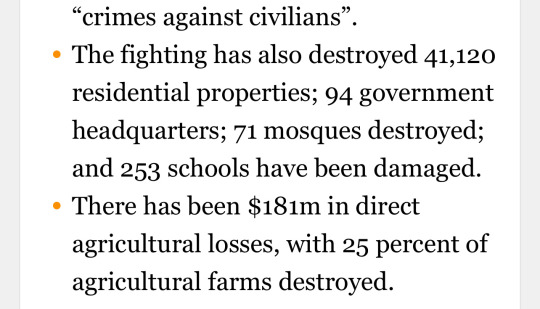
Alt: “More from Gaza health ministry’s daily update. Gaza health ministry’s deputy director general Ismail al-Thawabta just gave the latest updates. Here’s what he said. Ten people – “kids, babies, patients and wounded” – were unable to be rescued at al-Shifa hospital due to operation rooms being shuttered from lack of fuel. If fuel shortage causes communications and internet black, which is projected to happen on Thursday, “all the crimes of Israel will be hidden from the world” and will move the humanitarian crisis from “bad to worse”. Fuel must be allowed into Gaza and Rafah crossing with Egypt must be fully opened. Israel and the international community – particularly the United States – are fully responsible for “crimes against civilians”. The fighting has also destroyed 41,120 residential properties; 94 government headquarters; 71 mosques destroyed; and 253 schools have been damaged. There has been $181m in direct agricultural losses, with 25 percent of agricultural farms destroyed.”
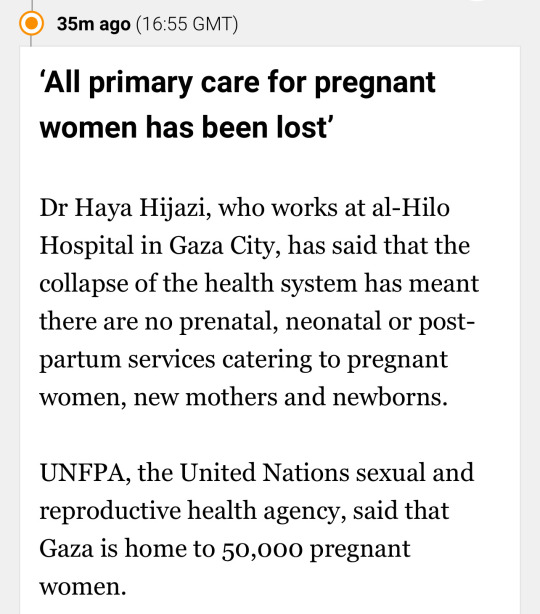
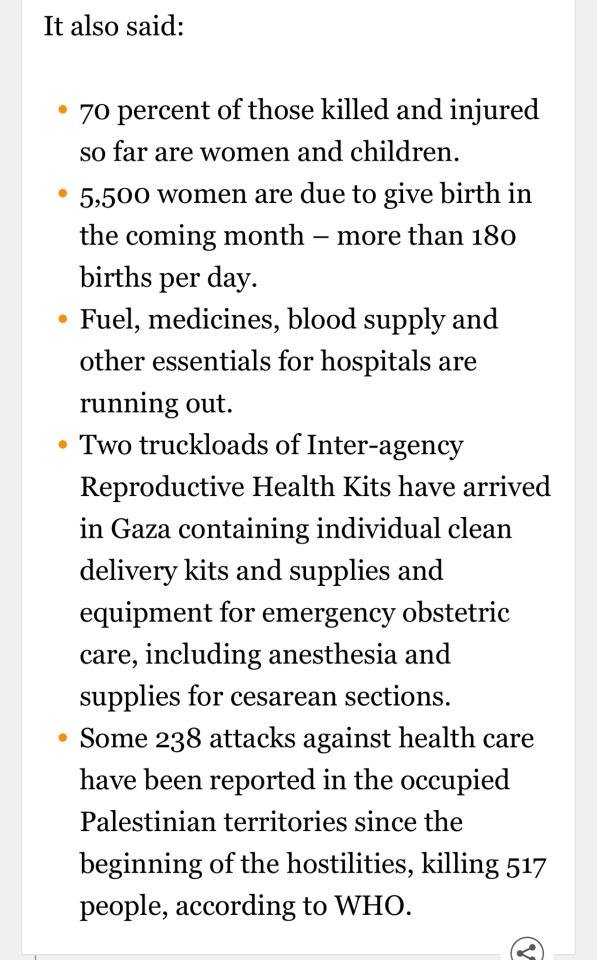
Alt: “‘All primary care for pregnant women has been lost’ Dr Haya Hijazi, who works at al-Hilo Hospital in Gaza City, has said that the collapse of the health system has meant there are no prenatal, neonatal or postpartum services catering to pregnant women, new mothers and newborns. UNFPA, the United Nations sexual and reproductive health agency, said that Gaza is home to 50,000 pregnant women.”
“It also said: 70 percent of those killed and injured so far are women and children. 5,500 women are due to give birth in the coming month – more than 180 births per day. Fuel, medicines, blood supply and other essentials for hospitals are running out. Two truckloads of Inter-agency Reproductive Health Kits have arrived in Gaza containing individual clean delivery kits and supplies and equipment for emergency obstetric care, including anesthesia and supplies for cesarean sections. Some 238 attacks against health care have been reported in the occupied Palestinian territories since the beginning of the hostilities, killing 517 people, according to WHO.”

Alt: “More from UNRWA’s Gaza chief. Thomas White said: “This morning, two of our main water distribution contractors ceased working – they simply ran out of fuel – which will deny 200,000 people potable water.”We earlier reported White’s warning that operations in Gaza by the United Nations Relief and Works Agency for Palestine Refugees (UNRWA) would shut down within two days due to fuel shortages. Israel has not allowed fuel to enter the Gaza Strip since before October 7. Earlier on Monday, the health ministry said all hospitals in the northern Gaza Strip had stopped functioning as a result of the impact of fuel shortages and intense ongoing fighting.”

Alt: “Al-Ahli now the ‘only hospital in all of Gaza City’: Doctor. Surgeon Ghassan Abu Sitta spoke to Al Jazeera from al-Ahli Hospital, which he said was now the only operating hospital in all of Gaza City after al-Shifa and al-Quds were forced to almost completely close. “Ever since the collapse of al-Shifa Hospital, we have become the only functioning Hospital in Gaza City,” he said. “If you recall, this is the hospital that was targeted initially by the Israelis at the beginning of the war and so parts of the hospital were damaged,” he said, referring to the October 17 blast at the hospital. Israel has denied it was behind that explosion, which Palestinian health officials said killed over 470 people.”
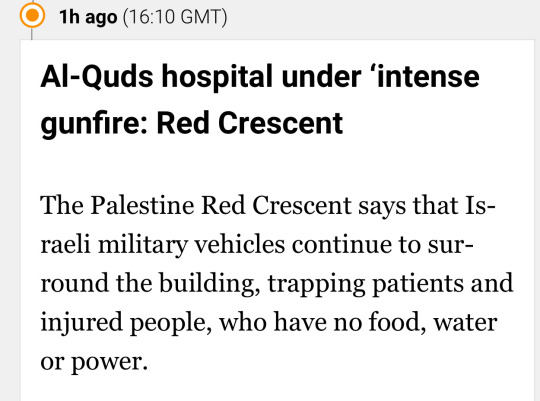
Alt: “Al-Quds hospital under ‘intense gunfire: Red Crescent. The Palestine Red Crescent says that Israeli military vehicles continue to surround the building, trapping patients and injured people, who have no food, water or power.”
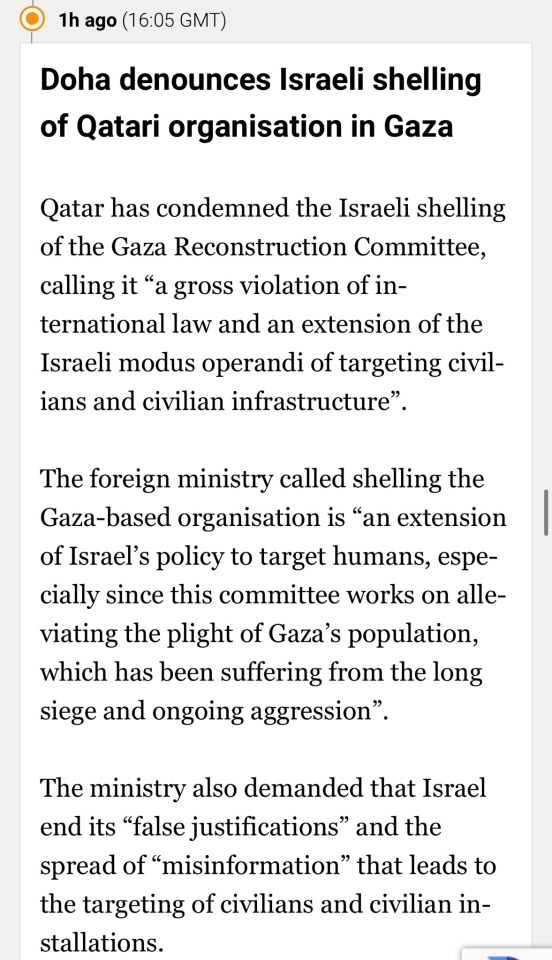
Alt: “Doha denounces Israeli shelling of Qatari organisation in Gaza. Qatar has condemned the Israeli shelling of the Gaza Reconstruction Committee, calling it “a gross violation of international law and an extension of the Israeli modus operandi of targeting civilians and civilian infrastructure”. The foreign ministry called shelling the Gaza-based organisation is “an extension of Israel’s policy to target humans, especially since this committee works on alleviating the plight of Gaza’s population, which has been suffering from the long siege and ongoing aggression”. The ministry also demanded that Israel end its “false justifications” and the spread of “misinformation” that leads to the targeting of civilians and civilian installations.”
Sources at AlJazeera, Check out further updates there too.
4 notes
·
View notes